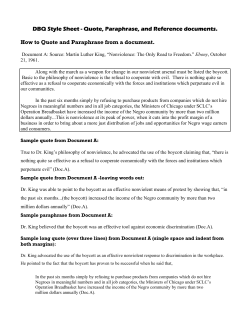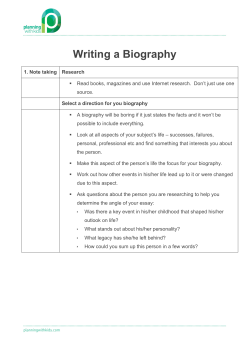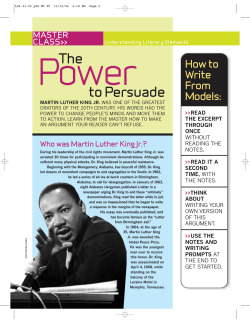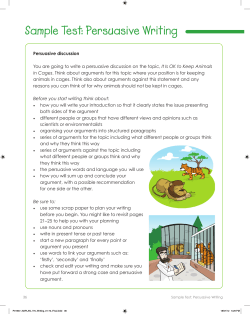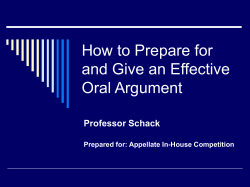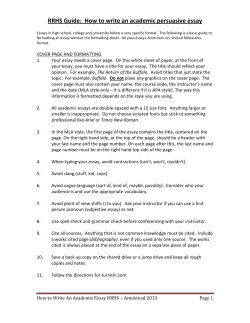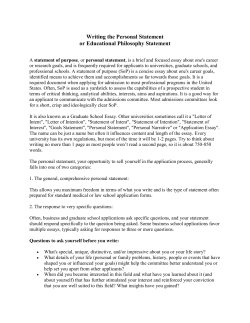
Writing the Persuasive Essay What is a persuasive/argument essay?
Writing the Persuasive Essay What is a persuasive/argument essay? In persuasive writing, a writer takes a position FOR or AGAINST an issue and writes to convince the reader to believe or do something Persuasive writing, also known as the argument essay, utilizes logic and reason to show that one idea is more legitimate than another idea. It attempts to persuade a reader to adopt a certain point of view or to take a particular action. The argument must always use sound reasoning and solid evidence by stating facts, giving logical reasons, using examples, and quoting experts. When planning a persuasive essay, follow these steps 1. Choose your position. Which side of the issue or problem are you going to write about, and what solution will you offer? Know the purpose of your essay. 2. Analyze your audience. Decide if your audience agrees with you, is neutral, or disagrees with your position. 3. Research your topic. A persuasive essay must provide specific and convincing evidence. Often it is necessary to go beyond your own knowledge and experience. You might need to go to the library or interview people who are experts on your topic. 4. Structure your essay. Figure out what evidence you will include and in what order you will present the evidence. Remember to consider your purpose, your audience, and your topic. The following criteria are essential to produce an effective argument • Be well informed about your topic. To add to your knowledge of a topic, read thoroughly about it, using legitimate sources. Take notes. • Test your thesis. Your thesis, i.e., argument, must have two sides. It must be debatable. If you can write down a thesis statement directly opposing your own, you will ensure that your own argument is debatable. • Disprove the opposing argument. Understand the opposite viewpoint of your position and then counter it by providing contrasting evidence or by finding mistakes and inconsistencies in the logic of the opposing argument. • Support your position with evidence. Remember that your evidence must appeal to reason. Parts of the Persuasive Essay 1. The Introduction The introduction has a "hook or grabber" to catch the reader's attention. Some "grabbers" include: 1. Opening with an unusual detail: (Manitoba, because of its cold climate, is not thought of as a great place to be a reptile. Actually, it has the largest seasonal congregation of garter snakes in the world!) 2. Opening with a strong statement: (Cigarettes are the number one cause of lighter sales in Canada!) 3. Opening with a Quotation: (Elbert Hubbard once said , "Truth is stronger than fiction.") 4. Opening with an Anecdote: An anecdote can provide an amusing and attention-getting opening if it is short and to the point. 5. Opening with a Statistic or Fact: Sometimes a statistic or fact will add emphasis or interest to your topic. It may be wise to include the item's authoritative source. 6. Opening with a Question. (Have you ever considered how many books we'd read if it were not for television?) 7. Opening with an Exaggeration or Outrageous Statement. (The whole world watched as the comet flew overhead.) The introduction should also include a thesis or focus statement. The Thesis/Hypothesis is your statement of purpose. The thesis/hypothesis should be one sentence in length. This is the foundation of your essay and it will serve to guide you in writing the entire paper. There are three objectives of a thesis statement: 1. It tells the reader the specific topic of your essay. 2. It imposes manageable limits on that topic. 3. It suggests the organization of your paper. Through the thesis, you should say to the reader: "I've thought about this topic, I know what I believe about it, and I know how to organize it." 2. The Body The writer then provides evidence to support the opinion offered in the thesis statement in the introduction. The body should consist of at least three paragraphs. Each paragraph is based on a solid reason to back your thesis statement. Since almost all issues have sound arguments on both sides of the question, a good persuasive writer tries to anticipate opposing viewpoints and provide counter-arguments along with the main points in the essay. One of the three paragraphs should be used to discuss opposing viewpoints and your counterargument. The following are different ways to support your argument: Facts - A powerful means of convincing, facts can come from your reading, observation, or personal experience. Note: Do not confuse facts with truths. A "truth" is an idea believed by many people, but it cannot be proven. Statistics - These can provide excellent support. Be sure your statistics come from responsible sources. Always cite your sources. Quotes - Direct quotes from leading experts that support your position are invaluable. Examples - Examples enhance your meaning and make your ideas concrete. They are the proof. Hints for successful body paragraphs: 1. Clarify your position in your topic sentence – state your argument or reason that supports your position (thesis), think about what needs to be explained, and then think about how you can elaborate. 2. Include Concession Statements (address opposing viewpoints!) : concession: If you're writing a persuasive piece, you might consider beginning with a concession--that is, by beginning with an acknowledgement of part of your opponent's argument as being valid. Remember that a concession is not a form of weakness. In fact a concession is a strength as it finds common ground with your opponent and establishes your ethical appeal: you are a reasonable person willing to listen to/acknowledge that there are more sides to an issue than yours. **You can’t ignore compelling opposing evidence. You must address strong arguments on the other side; if you don’t, it looks like you are not well prepared and have not looked at the issue you are writing about from all perspectives.** example: "True, gun control legislation in Canada needs to be tightened to prevent the United States from becoming as violent as its neighbors to the south. The proposal that has been submitted, however, does not go far enough. Instead,…[now writer begins building his side of argument, showing how it is stronger than the opposing side’s!] 3. Use transitions between sentences to serve as cues for the reader (first, second, then, however, consequently, therefore, thus, still, nevertheless, notwithstanding, furthermore, in fact, in contrast, similarly, instead) 3. The Conclusion A piece of persuasive writing usually ends by summarizing the most important details of the argument and stating once again what the reader is to believe or do. 1. Restate your thesis or focus statement. 2. Summarize the main points: The conclusion enables your reader to recall the main points of your position. In order to do this you can paraphrase the main points of your argument. 3. Write a personal comment or call for action. You can do this: o With a Prediction: This can be used with a narrative or a cause and effect discussion. The conclusion may suggest or predict what the results may or may not be in the situation discussed or in similar situations. o With a Question: Closing with a question lets your readers make their own predictions, draw their own conclusions. o With Recommendations: A recommendations closing is one that stresses the actions or remedies that should be taken. o With a Quotation: Since a quotation may summarize, predict, question, or call for action, you may use a quotation within a conclusion for nearly any kind of paper. As a general guideline, when writing a persuasive essay: 1. Have a firm opinion that you want your reader to accept. 2. Begin with a grabber or hook to get the reader's attention. 3. Offer evidence to support your opinion. 4. Conclude with a restatement of what you want the reader to do or believe. Persuasive Essay Outline Introduction: A. B. C. Get the readers attention by using a "hook." Give some background information if necessary. Thesis or focus statement. I. First argument or reason to support your position: A. B. C. D. Topic sentence explaining your point and reason Possible concession toward opposing argument Elaboration to back your point. Clincher II. Second argument or reason to support your position: A. B. C. D. Topic sentence explaining your point and reason Possible concession toward opposing argument Elaboration to back your point. Clincher III. Third argument or reason to support your position: A. B. C. D. Topic sentence explaining your point and reason Possible concession toward opposing argument Elaboration to back your point. Clincher IV. Opposing Viewpoint: (This is optional, however highly recommended, so that the reader will know you have considered another point of view and have a rebuttal to it.) A. B. C. Opposing point to your argument. Your rebuttal to the opposing point. Elaboration to back your rebuttal. Conclusion: A. B. C. Summary of main points or reasons Restate thesis statement. Personal comment or a call to action. Transition Signals: Transitions are words and phrases that connect ideas and show how they are related. To repeat an idea just stated: In other words, That is, To repeat, Again, To illustrate an idea: For example, For instance, In particular, To illustrate, In this manner, Thus To announce a contrast, a change in direction: Yet, However, Still, Nevertheless, On the other hand, In contrast, Instead of, On the contrary, Conversely, Notwithstanding, In spite of this, Time: At once, In the interim, At length, Immediately, At last, Meanwhile, In the meantime, Presently, At the same time, Shortly, In the end, Temporarily, Thereafter, To restate an idea more precisely: To be exact, To be specific, To be precise, More specifically, More precisely, To mark a new idea as an addition to what has been said: Similarly, Also, Too, Besides, Furthermore, Further, Moreover, In addition, To show cause and effect: As a result, For this reason, Therefore, Hence, Consequently, Accordingly, Conclusion: In short, To conclude, In brief, On the whole, In summary, To sum up, Conferencing with a Peer Ask someone to read your rough draft to see if they understand and can follow your argument. Ask them to consider the following questions. Their answers should show you that your argument makes sense. What is the thesis statement? How is the thesis explained? What are the main points of the argument? (3) 1. 2. 3. How did the author back up each point? 1. 2. 3. What are the opposing point(s)? What is the writer's solution?
© Copyright 2025


